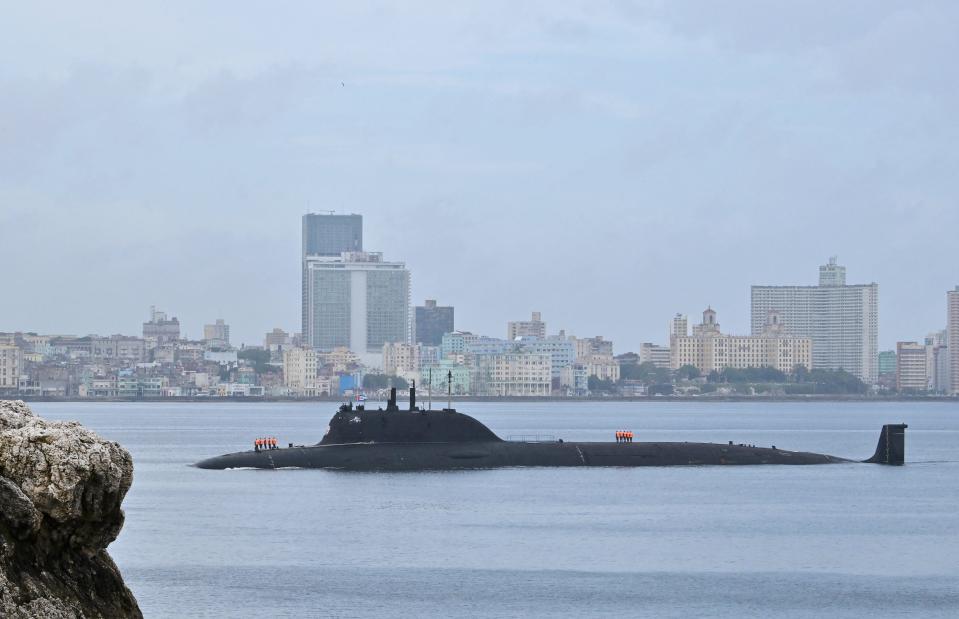US Navy nuclear ballistic missile submarine surfaces off Norway in unusual flex as 'Doomsday' plane flies overhead
A US Navy nuclear-powered ballistic-missile submarine surfaced in the Norwegian Sea.
It was accompanied by a guided-missile cruiser and two naval aircraft.
The show of force came weeks after Russia sent a submarine and naval fleet to Cuba.
A US Navy nuclear-powered ballistic submarine popped up in the Norwegian Sea this week in a rare show of force. It was accompanied by a guided-missile cruiser and two naval aircraft.
US Naval Forces Europe-Africa/US 6th Fleet announced the movement of the USS Tennessee (SSBN 734) in the Norwegian Sea on Tuesday, writing that the sub was joined by the USS Normandy (CG 60) as well as a P-8A Poseidon maritime patrol and reconnaissance aircraft and an E-6B Mercury strategic communications plane.
Multi-Domain Readiness in action 🚁🌊🔱 @USNavy 🇺🇸 guided-missile cruiser #USSNormandy (CG 60) and ballistic missile submarine #USSTennessee (SSBN 734) steam alongside in the #NorwegianSea while a P-8A Poseidon and E-6B Mercury fly overhead, June 23, 2024. pic.twitter.com/8Uttvmkny9
— U.S. Naval Forces Europe-Africa/U.S. 6th Fleet (@USNavyEurope) June 25, 2024
Per the US military post on X, the fleet was in the Norwegian Sea on Sunday. The specific intention wasn't overtly stated, but these assets send a message to potential adversaries.
The flex notably comes amid persistent tensions with Russia, which has been rattling the nuclear saber lately, and just a few weeks after Russia sent a naval flotilla, including one of its own nuclear-powered subs, to Cuba.
The USS Tennessee is an Ohio-class ballistic-missile sub able to carry as many as 20 Trident nuclear missiles. Its accompanying E-6B Mercury "provides survivable, reliable, and endurable airborne Nuclear Command, Control, and Communications (NC3) for the president, secretary of defense, and US Strategic Command," according to Naval Air Systems Command.
Like the Air Force E-4B "Nightwatch," the Navy plane is sometimes called the "Doomsday plane," as it can relay National Command Authority directives to US submarines as part of the "Take Charge and Move Out" mission and fulfill "Looking Glass" obligations, which involves directing nuclear forces if the ground-based options are gone.
The E-6B Mercury had been tracked flying an operation off the coast of Norway on Sunday, which Hans Kristensen, the director of the Nuclear Information Project at the Federation of American Scientists, wrote on X "indicated forward operations with nuclear missile submarines."
As suspected, deployment of E-6B TACAMO nuclear command, control and communication aircraft to Norway indicated forward operations with nuclear missile submarines. https://t.co/EqaeAH2oK6
What I didn't expect was one of them surfacing off Norway in a blunt signal to Russia. 👀 https://t.co/SK7NHMNYtq— Hans Kristensen (@nukestrat) June 25, 2024
While Kristensen said this was expected, he said he didn't expect to see a nuclear sub surface, calling it "a blunt signal to Russia."

As the "boomers," or ballistic-missile subs, are an element of the US nuclear triad, the US Navy doesn't regularly reveal where they are. Other elements of the submarine force also tend to be far less visible than the surface fleet.
But since 2020, it has been more frequently making its presence known in the North Atlantic and nearby seas, particularly around Norway and other NATO allies. Part of this reflects increased cooperation between Norway, the US, and other NATO partners.
Deliberately revealing the locations of submarines signals to Russia that American submarines are active in waters nearby, and it does so at a time when Russian subs are increasingly active in the Atlantic and even off US shores. The boomers also notably send a message of nuclear deterrence.
The US has made similar revelations in other parts of the world with its Ohio-class cruise-missile submarines, which carry 154 land-attack Tomahawks.
Russia, too, is often intentional with how and when it reveals the movements of its subs, particularly its Severodvinsk-class submarines, which have concerned NATO officials for years.
Russia made a show of having one of these vessels, the first-in-class Severodvinsk, surface off Norway in July 2022, and another one of these submarines, the Kazan, was spotted in Cuba earlier this month during a five-day official visit. Other Russian vessels, such as the Admiral Gorshkov frigate, joined the Kazan during the visit ahead of an air and maritime exercise in the Caribbean.
Read the original article on Business Insider


